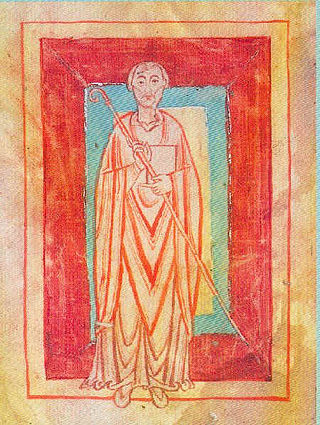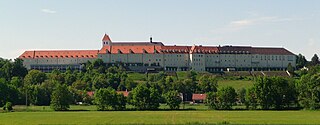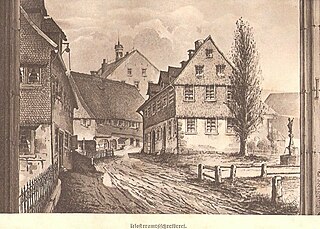Benedictines
The nunnery was under the supervision of the Benedictine St. George's Abbey in the Black Forest, of which until the 18th century it was a priory.
Before the foundation of the nunnery there had been a community of monks on the site, which came to an end after a serious fire. Abbot Theoger of St. George's (1088-1119) replaced it with the nunnery, which was made subordinate to St. George's in 1184, according to a deed of Pope Lucius III. In about 1400 a monk of St. George's was mentioned as the prior here, as were possessions of the nunnery in Geberschweier and Osenbach.
In 1710 a beer brewery was built there. [1]
In 1754 the priory was transferred from St. George's to Ebersmünster Abbey in Alsace.
In 1845 the premises, empty since the French Revolution, were used by Abbé Pierre Paul Blanck to establish a women's community under the Benedictine Rule combining the veneration of the Holy Sacrament with manual labour and the care of orphans. The buildings burnt down in 1852 and the difficulties facing the new community were so great that it seemed impossible for it to survive. Against all odds it did continue and was constituted as a formal order on 9 October 1868 with the election and appointment of Sister Maria Xavier as superior.
At the end of World War I the German sisters were expelled from Alsace and obliged to look for new premises in Germany, which in 1919 they found in the former St. Trudpert's Abbey in Münstertal. These are now the Sisters of St. Joseph of St. Trudpert.
The French community continues as the Sisters of St. Joseph of St. Marc.

William of Hirsau was a Benedictine abbot and monastic reformer. He was abbot of Hirsau Abbey, for whom he created the Constitutiones Hirsaugienses, based on the uses of Cluny, and was the father of the Hirsau Reforms, which influenced many Benedictine monasteries in Germany. He supported the papacy in the Investiture Controversy. In the Roman Catholic Church, he is a Blessed, the second of three steps toward recognition as a saint.

Ulrich of Zell, also known as Wulderic, sometimes of Cluny or of Regensburg, was a Cluniac reformer of Germany, abbot, founder and saint.

Mallersdorf Abbey was formerly a monastery of the Benedictine Order and is now a Franciscan convent in Mallersdorf-Pfaffenberg in Bavaria.

St Peter's Abbey in the Black Forest or St. Peter's Abbey, Schwarzwald is a former Benedictine monastery in the village of St. Peter im Schwarzwald, in the district of Breisgau-Hochschwarzwald, Baden-Württemberg, Germany.

St. Ulrich's Priory in the Black Forest was a priory of Cluny Abbey founded in the valley of the River Möhlin in the Black Forest in about 1083. St. Ulrich is now part of the municipality of Bollschweil, in the district of Breisgau-Hochschwarzwald, Baden-Württemberg, Germany.
Sölden Priory was initially a Cluniac monastery of nuns, established in 1115 at Sölden in the district of Breisgau-Hochschwarzwald in the Black Forest, Baden-Württemberg, Germany. In the 16th century it became a community of monks.

Saint Blaise Abbey was a Benedictine monastery in the village of St. Blasien in the Black Forest in Baden-Württemberg, Germany.

St. George's Abbey in the Black Forest was a Benedictine monastery in St. Georgen im Schwarzwald in the southern Black Forest in Baden-Württemberg, Germany.

Gengenbach Abbey was a Benedictine monastery in Gengenbach in the district of Ortenau, Baden-Württemberg, Germany. It was an Imperial Abbey from the late Carolingian period to 1803.

St. George's Abbey, Stein am Rhein was a Benedictine monastery in Stein am Rhein, Switzerland.

St. Trudpert's Abbey is a former Benedictine monastery in Münstertal in the southern Black Forest, Baden-Württemberg, Germany, now the principal house of the Sisters of St. Joseph of St. Trudpert.

The Sisters of St. Joseph of Saint-Marc (SJSM) are a Roman Catholic congregation of religious sisters, based in the town of Saint-Marc, Alsace, France.

St. George's Abbey, Isny in Isny im Allgäu in Baden-Württemberg, Germany, is a former Benedictine abbey founded in 1096 and secularised in 1802.
Berchtold von Falkenstein was abbot of the Benedictine Abbey of Saint Gall from 1244 until 1272.
This page is based on this
Wikipedia article Text is available under the
CC BY-SA 4.0 license; additional terms may apply.
Images, videos and audio are available under their respective licenses.












